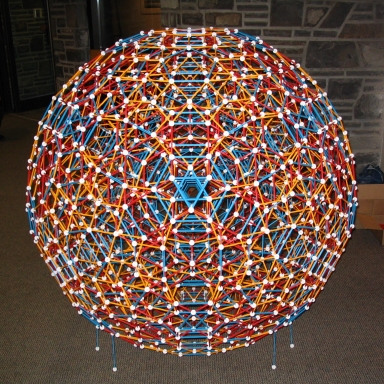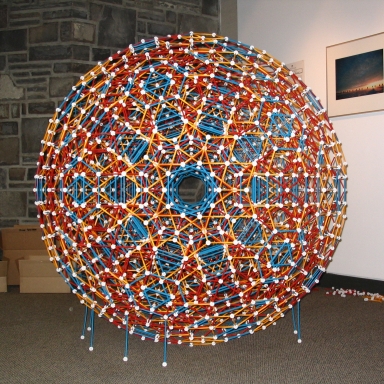Zome Project

The Zome-Builders on Coxeter Day
(Click for a higher-resolution image.)
Introduction.
During the Renaissance Banff Bridges 2005 Conference, Daniel Duddy, a student at City College of New York, and I led the constructions of two large Zome models. In the photo above, Dan is wearing a black t-shirt and sitting on the ground in front of the model on the right. Both of these objects model orthogonal (or "shadow") projections of 4-dimensional convex uniform polytopes sharing the same symmetry group with the 600-cell, the "cantellated" H4 polychora.
Remarkably, both models require the same inventory of pieces, namely, 1860 connector balls, 1080 short red struts, 1080 medium red struts, 1800 medium yellow struts, and 1380 medium blue struts. Paul Hildebrandt of Zometool generously brought all the pieces direct from the Zome factory to be used for the project. We used non-marketable out-of-spec balls, and, due to their unusually tight-fitting holes, this contributed immensely to the structural integrity of the models. We assembled the models in the foyer of the Max Bell Building on the campus of the Banff Centre.
The Cantellated 600-Cell.

The Cantellated 600-Cell, generic view
On Saturday July 30, the day before the conference began, we constructed a model of the cantellated 600-cell. The construction of this model went by relatively slowly because we didn't have many helpers. Dan Duddy and I worked on it throughout most of the day, although Paul Gailiunas, George Hart, and Paul Hildebrandt also contributed when they found the time. This construction had two phases. First we made a few dozen models of various compressions of the icosidodecahedron, and then we bound these together along the lateral edges of the required pentagonal prisms. This is analogous to the construction of the Zome model of the 600-cell, except that one uses icosidodecahedra instead of single balls and sets of five struts instead of single struts. The total construction time was about 10 hours.
|
|
|
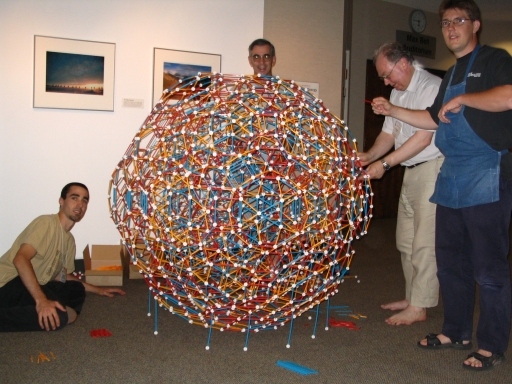
DR christening his "Zome Apron"
The Cantellated 120-Cell.
On Sunday July 31, we started the construction of a model of the cantellated 120-cell, and we completed the construction on Monday August 1. We had a lot more help for this model, especially from the youngest participants in the conference. This construction had two phases. First we made a few hundred models of various compressions of the regular octahedron, and then we bound these together along the lateral edges of the required triangular prisms. This is analogous to the construction of the Zome model of the 120-cell, where one uses octahedra instead of single balls and sets of three struts instead of single struts.

Dedicated and Enthusiastic Zomers
After we had about half the octahedra assembled into a whole, the conference organizer Reza Sarhangi strongly advised us to stop for awhile. This served both to give everyone a break and to allow the other participants in the conference a chance to appreciate a Zome project in progress. As the photos may show, Zome models are often interesting even when they are only partially completed. We completed the model on Monday August 1. The total construction time was about 6-7 hours.
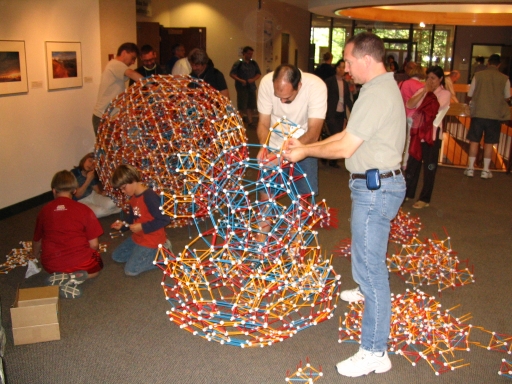
The Cantellated 120-Cell, a Work In-Progress
To Be Continued....
Naturally, after all this work, we had to settle the question of what to do with the models after the conference ended. Luckily, the Zometool company was willing to donate both models. (If they hadn't been, then we would have been forced to spend several sad hours dis-assembling.) The model of the cantellated 600-cell went to the Banff International Research Station (BIRS), and that of the cantellated 120-cell was donated to the Pacific Institute of Mathematical Sciences (PIMS). Neither model could fit through any of the doors in the Max Bell Building, so we had to determine the best ways to take them apart and re-assemble them.
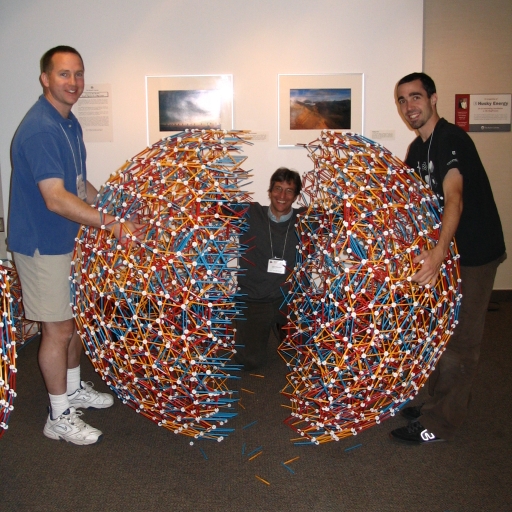
A Successful Dissection
We dissected the cantellated 600-cell along a 2-fold plane of symmetry, moved each half through several doorways leading to the BIRS lounge, and then carefully re-attached the two halves. If you ever visit BIRS, you should have no difficulty noticing this model, assuming it stays together.

The cantellated 600-cell finds a home.
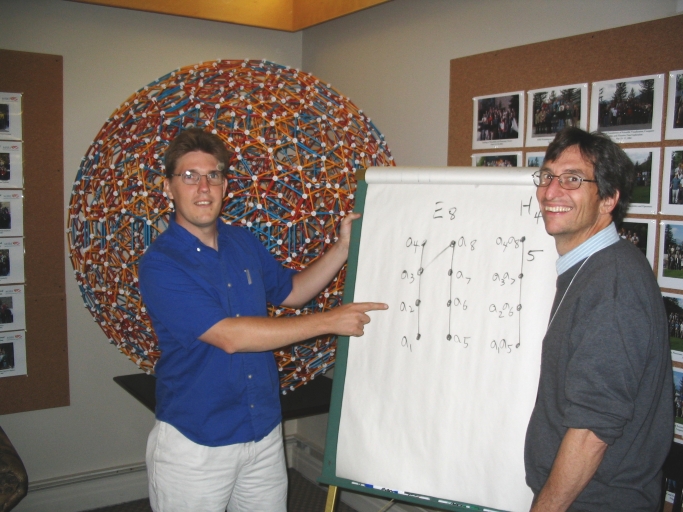
DR explains a theory about "how Zome works" to Paul.
We trisected the model of the cantellated 120-cell along two parallel planes which intersected only lateral edges of the prisms making up the model. Initially we thought that we could fit the three pieces into Nassif Ghoussoub's minivan so that he could drive it back to Vancouver. However, we quickly learned that we could not fit it without dis-assembling the model into an impracticably large number of pieces. As of this writing, the three pieces are in storage at BIRS, waiting for a larger van or a truck to transport them to Vancouver, where, if anyone knows how, they will be re-assembled.

A trisectant of the cantellated 120-cell.
Many thanks go to everyone who helped build and to the organizers of Renaissance Bridges.
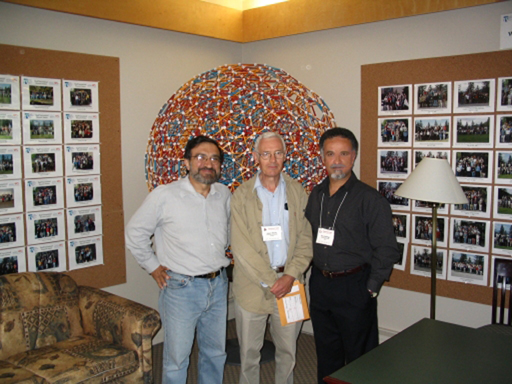
Organizers Nassif Ghoussoub, Robert Moody, and Reza Sarhangi
August 5, 2005
